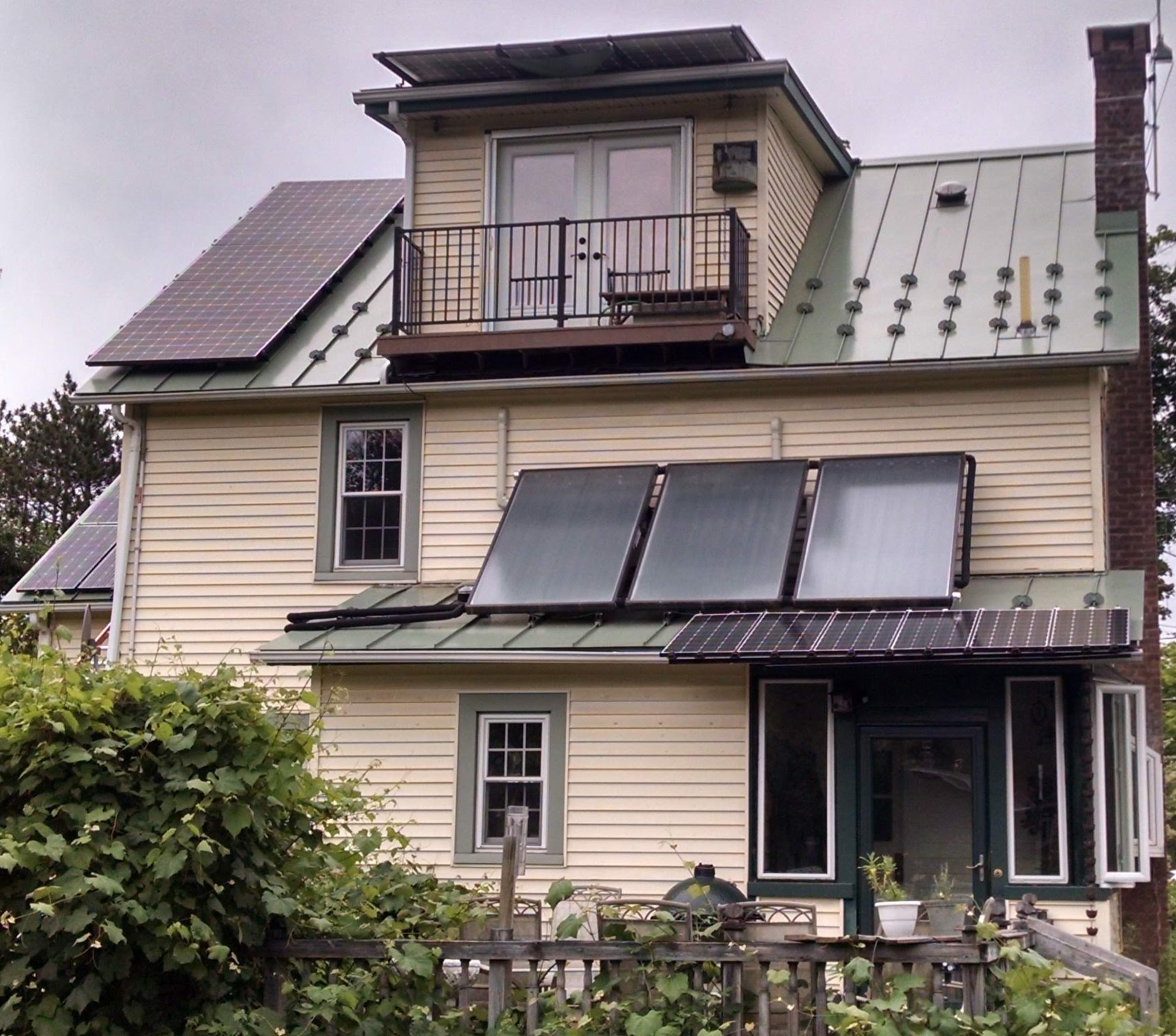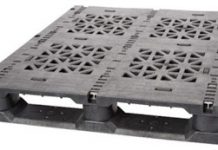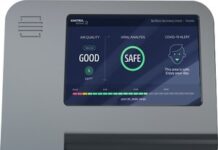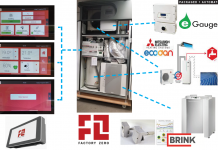Note: The following is a handout written by AltEnergyStocks Editor Tom Konrad at the request of a leading local Realtor where he lives in Ulster County, NY. It is intended as a handout that local Realtors can give to new homeowners who express an interest in reducing their home energy use and using renewable energy. Some of the information and may not be applicable if you live in other areas because of varying climate, energy costs, and regulation. While most of the locally specific has been removed from this version, and the remainer is broadly applicable, homeowners in other parts of the country should look for similar, local resources specific to their climate and local regulations and incentives. A good place to start is with your local electric utility.
 Solar
Solar
What makes a home good for solar electric?
- New roof, metal roof, or roof in need of replacement (replace first.)
- Large, unobstructed roof surface(s) on the S, E, or W side, or unobstructed flat roofs.
- Trees or structures to the south (or SE for E facing roofs, and SW for W facing roofs should be more than twice as far from the roof as they are taller than it. I.e. a tree standing 20’ to the south of a roof surface being considered for solar should be no more than 10’ taller than the roof, and should not be expected or allowed to grow past that height in 20 years.
- For homes with significant roof space, large electric bills due to electric heat, hot water, or electric vehicles improve economics. Consider also adding Air Source Heat Pumps and Heat Pump Water Heater, described below. Electric vehicles can greatly increase your electricity usage; most EVs get approx 4 miles of range per kWh, or 2,500 kWh for 10,000 miles/year of driving.
- If you are not sure, solar installers will evaluate any home for free. They can often tell if your home is suitable using satellite imaging, so this can be as simple as a phone call or email.
Community Solar
If a home is not suitable for solar, a community solar subscription or purchase can still lead to significant savings on the electric bill. The details and availability of community solar depend on your state’s regulators.
Fuel Oil and Propane
Fuel Oil and Propane are never green options, no matter how efficient your appliances. Use as many of the strategies listed below to reduce or convert as much of your energy use to electricity as possible, with wood pellet stoves and boilers as an efficient alternative that minimizes pollution compared to cordwood stoves (even Energy Star rated stoves.)
Natural Gas
If your home has access to natural gas, many of the following efficiency measures described in what follows will be less cost effective if they reduce natural gas instead of fuel oil or propane usage. Even when displacing natural gas, however, the efficient electrification strategies described below are the most environmentally sound options available.
Building Efficiency
Even newly built homes that were built to code can often benefit from cost effective air sealing and insulation. This process starts with an energy audit, many of which are subsidized.
The auditor will perform a blower door test and recommend a number of upgrades, which he/she may offer to perform. These upgrades are typically chosen for quick payback and should be considered a bare minimum. Many more upgrades can be cost effective and also increase home comfort and health.
Typical Efficiency upgrades
Bare minimum
- Replace all lighting with LED
- Use low-flow shower heads
- Spray foam sealing of basement rim joist.
- Air sealing around doors and windows.
- Blower door assisted air sealing
- Blow-in cellulose insulation in attics
- Heat Pump/ Hybrid Water Heater
To go beyond the bare minimum, you will want to work with a home energy efficiency specialist/ builder.
Home Heating
- Geothermal Heat Pump (both heat and A/C.) Can be expensive, but this is the most efficient option available. Some also produce hot water.
- Cold Climate Air Source Heat Pump (both heat and A/C) not as efficient as geothermal heat pumps, but usually a more cost effective option for well insulated houses) Can be used to supplement other heat sources and still deliver cost savings if your home is not yet well insulated.
- Pellet stove (rebates available for replacing existing wood stoves)
Air Conditioning:
If you are installing or replacing an air conditioner, get a cold climate rated air source heat pump instead to also benefit from reduced heating costs in winter.
Ceiling fans are an inexpensive and extremely energy efficient supplement to air conditioning, not just an alternative to it. Look for Energy Star models. By increasing air movement in occupied rooms, they can allow you to maintain comfort at a higher temperature.
Appliances – energy efficient and cost effective choices
Oven – Electric Convection
Range – Induction (requires steel or cast iron cookware, but better temperature control and power than gas or propane.) Cheap induction hot plates are also available if you want to try out the technology or supplement your existing stove, but they typically lack the fine control and high power available with a stovetop.
Hot Water –
- Heat Pump or Hybrid Hot Water Heater
- Solar Hot Water can be a cost effective option for large families, businesses, and multifamily dwellings that have large, consistent hot water demand. Will require a supplemental source of hot water in winter.
- Solar hot water pool heating – an inexpensive and very cost effective option for extending the swimming season.
Dishwasher, Clothes washer – choose Energy Star models. Wash with cold water.
Clothes drying:
- Consider a clothesline or drying rack (at least as a supplement.)
- Condensing dryers (a technology often used in combination washer/dryers) are very energy efficient but are less effective at removing wrinkles than conventional dryers.
- Conventional electric dryers may be a little more expensive to run than propane dryers (depending on propane prices), but can use renewable electricity and allow for a larger solar installation if your home is suitable.
Refrigerator/Freezer. Configurations is very important to energy use; Energy Star only compares models with similar configuration/size/features. Compare actual energy use ratings, not just if a model is Energy Star or not.
- Central Hudson will take away your old working fridge/freezer for free and give you $50
- Chest freezers are the most efficient stand alone models
- Top freezer refrigerator without through the door ice and water is the most energy efficient configuration.
TV/Computer monitor: LED most efficient. Avoid plasma TVs. Choose energy star models.
Electric Vehicle Charging
Electric Vehicles can charge from any 120V outlet, but they do so slowly and will only gain 30-40 miles range in a typical overnight charge this way. This is a good option for people who do not drive much, or who purchase a plug-in hybrid electric vehicle, which combines a short electric range with a gasoline engine.
Most drivers considering a pure electric vehicle will want to install a “Level II” charging station. This requires 240V power. The installation will be relatively easy and inexpensive if the home has its main panel or a subpanel located near the parking space where you hope to charge. If you are already having electrical work done on your home, consider having an RV outlet (aka NEMA 14-50) installed near the parking space you intend to use. All the best electric vehicle charging brands come with plug-in options that use this type of outlet. If you already have any 240 volt outlet such as a dryer outlet near where you park, you will also be able to purchase an EV charging station which can use that. Level 2 EV charging stations that use these types of outlets can be purchased for $200 to $900 depending on what features you want.
If you think electric vehicles are too expensive, consider a used EV, especially as a second vehicle. They are surprisingly inexpensive.








